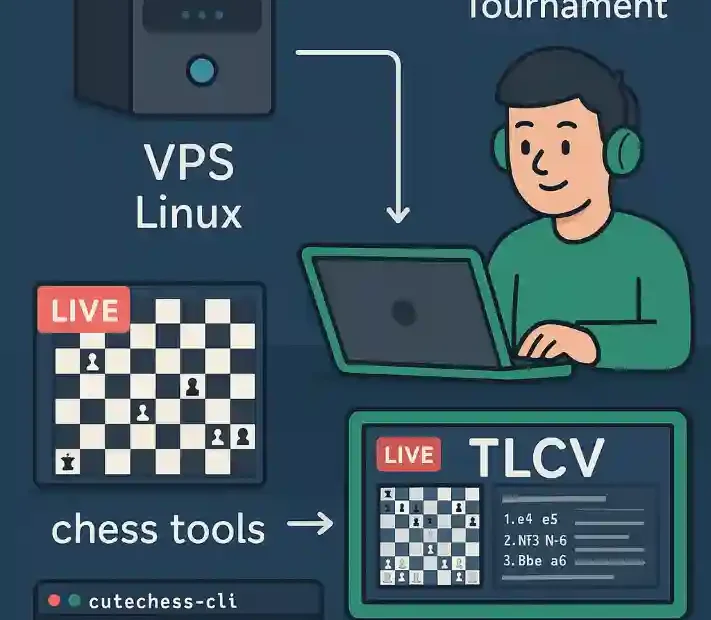Introduction to Chess Broadcasting Infrastructure
In today’s digital chess landscape, real-time broadcasting has revolutionised how enthusiasts engage with tournaments. At the core of this transformation lies the powerful combination of Virtual Private Servers (VPS), Node.js, and specialised chess tools like Tom’s Live Chess Viewer (TLCV). For organisers seeking professional streaming capabilities without enterprise costs, implementing TLCV on a Linux VPS offers unprecedented flexibility. This guide demystifies the entire process—from server selection to tournament automation—using cutechess-cli for robust engine battles. Whether broadcasting local club matches or international grandmaster clashes, this solution transforms any Linux environment into a chess broadcasting powerhouse.
A Virtual Private Server (VPS) provides dedicated resources within a shared hosting environment, offering greater control than standard hosting while avoiding physical server costs. Node.js serves as our execution environment—its event-driven architecture handles multiple chess streams simultaneously with minimal resource consumption. TLCV acts as the visualisation layer, translating raw game data into interactive boards using web technologies. Complementing this ecosystem, cutechess-cli enables automated engine tournaments through terminal commands. This integrated approach creates a scalable broadcasting framework where games initiated via cutechess-cli automatically appear in your TLCV interface for global audiences.
Core Technology Foundations
Virtual Private Server (VPS) Essentials
Virtualisation technology partitions physical servers into isolated virtual machines, each with dedicated:
- CPU cores (1-8 vCPUs recommended)
- RAM allocation (2GB minimum for chess workflows)
- Storage (SSD preferred, 20GB+)
- Bandwidth (1TB+ monthly transfer)
- Root access via SSH
Leading providers include DigitalOcean, Linode, and Vultr, offering Linux VPS from £3/month. For chess broadcasting, Ubuntu 22.04 LTS provides ideal stability with long-term support until 2032.
Node.js Runtime Environment
Node.js executes JavaScript outside browsers using Google’s V8 engine. Key advantages:
- Non-blocking I/O handles concurrent game streams
- NPM ecosystem with 2.1 million packages
- Cluster module for multi-core utilisation
- PM2 process manager ensures 24/7 uptime
Tom’s Live Chess Viewer (TLCV)
Originally developed for FICS (Free Internet Chess Server), TLCV features:
- Real-time PGN parsing
- WebSocket communication
- Multi-board support
- Spectator chat integration
- Customisable themes

Cutechess-CLI Tournament Engine
This command-line tool orchestrates engine matches with:
- UCI/XBoard protocol support
- Concurrent game management
- Opening book integration
- Result aggregation in PGN/CSV
- Elo rating calculations
VPS Configuration Walkthrough
Server Initialisation
- Select Provider: Choose VPS plan (1 vCPU, 2GB RAM minimum)
- Operating System: Ubuntu 22.04 LTS (64-bit)
- Authentication: Generate SSH key pair for secure access
- Connect: Use Terminal (macOS/Linux) or PuTTY (Windows):
ssh -i ~/.ssh/your_key.pem root@your_server_ipSecurity Hardening
Critical first steps after login:
# Update repositories
apt update && apt upgrade -y
# Create limited user
adduser chessadmin
usermod -aG sudo chessadmin
# Configure firewall
ufw allow OpenSSH
ufw allow 8080/tcp # For TLCV
ufw enable
# Disable root SSH
sed -i 's/PermitRootLogin yes/PermitRootLogin no/' /etc/ssh/sshd_config
systemctl restart sshdSoftware Installation Process
Node.js Implementation
Install via NodeSource repository:
# Install prerequisites
apt install -y curl git build-essential
# Add Node.js 18.x repository
curl -fsSL https://deb.nodesource.com/setup_18.x | bash -
# Install Node.js and build tools
apt install -y nodejs
# Verify installation
node -v # Should show v18.x
npm -v # Should show 9.x+PM2 Process Manager
Install globally and configure:
npm install -g pm2
# Generate startup script
pm2 startup systemd -u chessadmin --hp /home/chessadmin
# Save process list persistence
pm2 saveTLCV Deployment Methodology
Repository Acquisition
# Switch to user account
su - chessadmin
# Clone TLCV repository
git clone https://github.com/jhonnold/node-tlcv.git
cd node-tlcvConfiguration Setup
- Create config.json:
{
"connections": [
"fics.freechess.org:5000",
"your_secondary_server:port"
]
}Replace with actual TLCS endpoints
- Establish Environment Variables:
echo "TLCV_PASSWORD=YourSecurePassw0rd!" > .env
chmod 600 .env # Restrict permissionsBuild and Launch Process
# Install dependencies
npm install
# Build TypeScript code
npm run build
# Start in foreground (testing)
node build/src/main.js
# Launch with PM2 (production)
pm2 start build/src/main.js --name "TLCV"
# Configure auto-start
pm2 saveTournament Automation with Cutechess-CLI
Installation Steps
# Install dependencies
sudo apt install -y cmake libglib2.0-dev qtbase5-dev
# Clone repository
git clone https://github.com/cutechess/cutechess.git
cd cutechess
# Build from source
mkdir build && cd build
cmake .. -DCMAKE_BUILD_TYPE=Release
make -j$(nproc)
sudo make installEngine Battle Configuration
Sample tournament command:
cutechess-cli \
-engine name=Stockfish cmd=stockfish dir=/opt/engines/ \
-engine name=Komodo cmd=komodo-14.1 dir=/opt/engines/ \
-each proto=uci tc=60+0.5 \
-games 100 -rounds 10 \
-pgnout games.pgn \
-tournament gauntlet \
-openings file=book.pgn format=pgn order=random \
-recover \
-concurrency 4Key parameters explained:
-each: Universal engine settingstc=60+0.5: 60 minutes + 0.5s increment-tournament gauntlet: One engine challenges others-concurrency: Parallel game threads
System Administration
Accessing TLCV Admin Panel
- Navigate to
http://your_server_ip:8080/admin - Username:
admin - Password: Value from
.envfile
Admin panel capabilities:
- Real-time connection monitoring
- Game session termination
- Bandwidth analytics
- Spectator management
- Log inspection
Maintenance Best Practices
- Resource Monitoring:
htop # Process viewer
nethogs # Bandwidth monitor- Log Management:
pm2 logs TLCV --lines 100 # View recent logs
pm2 flush TLCV # Clear logs- Scheduled Updates:
# Create maintenance cron job
crontab -e
# Add line: 0 3 * * * /home/chessadmin/update_chess.shSample update script (update_chess.sh):
#!/bin/bash
cd ~/node-tlcv
git pull origin master
npm install
npm run build
pm2 restart TLCVTroubleshooting Framework
Common Issues and Resolutions:
| Symptom | Diagnostic Command | Solution |
|---|---|---|
| Connection failures | nc -zv host port | Verify firewall rules |
| High CPU usage | pm2 monit | Limit concurrent games |
| Memory leaks | node --inspect | Profile with Chrome DevTools |
| Service crashes | journalctl -u pm2-chessadmin | Increase Node.js heap: NODE_OPTIONS=--max-old-space-size=2048 |
Network Configuration Verification:
# Check listening ports
ss -tulpn | grep 8080
# Test external access
curl -I http://localhost:8080Conclusion: Building Your Chess Broadcasting Empire
Implementing TLCV on a Linux VPS creates an incredibly powerful chess broadcasting platform accessible to organisers at all levels. By combining cost-efficient cloud infrastructure with open-source chess tools, you’ve built a system rivalling professional broadcast setups at minimal expense. The true power emerges when integrating components: cutechess-cli generates tournaments whose games automatically appear in TLCV, while PM2 ensures uninterrupted streaming even during server maintenance.
Consider these advanced enhancements:
- Implement NGINX reverse proxy with SSL termination
- Add authentication layer for private broadcasts
- Develop custom themes using TLCV’s CSS framework
- Integrate database persistence for game archiving
- Set up automated backup routines for PGN collections
The chess technology landscape continuously evolves—monitor repositories for updates and consider contributing improvements. With your VPS now functioning as a dedicated chess server, possibilities extend beyond broadcasting: create training platforms, analysis portals, or experimental AI testing grounds. Share your implementation experiences within the chess programming community to advance these vital open-source projects. Every game broadcast strengthens global chess connectivity—your server now helps write that history.
Sources Consulted:
- Node-TLCV GitHub Repository
- Chess Programming Wiki – TLCV
- Cutechess GitHub Repository
- Node.js Official Documentation
- Ubuntu Server Security Guide

Jorge Ruiz Centelles
Filólogo y amante de la antropología social africana
